Denver's Historic 17th Street
Union Station
By the early 1870s, a number of railroads connected Denver to the outside world. Prior to 1870, Denver remained a frontier town, with a population around 5,000 people. The arrival of the railroads changed Denver from frontier outpost to thriving boom town. By 1880, Denver's population was 35,000 and the town was well on its way to dominating the region's economy.
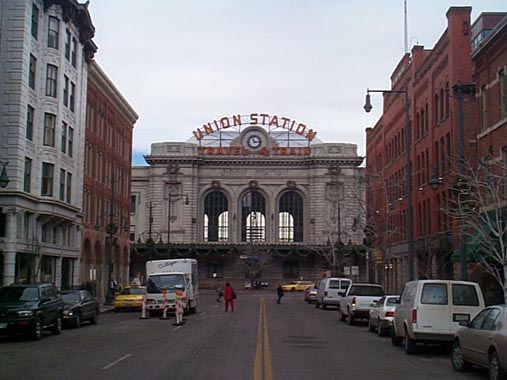
Photo: N/A
More About This Topic
At the time Union Station was first built, it was nearly four blocks from the built-up part of town. The arrival of the railroads in 1870 changed almost every aspect of Denver. In the next decade, the city's businesses grew toward Union Station. Business people built hotels, restaurants, warehouses, and other buildings in the Lower Downtown region to serve the growing flood of goods and people coming to Denver via the railroads. For a decade, the many railroad lines serving Denver each had its own depot or terminal. As a result, handling freight and passengers between the lines was difficult. As a result, tycoon Jay Gould and local resident Walter Cheesman hatched the idea of building one depot that would serve all the railroads. The original Union Station was therefore built in 1881. A fire in 1894 destroyed the middle portion of the original building. This part was rebuilt in 1894 and redone again in 1912.
Denver City Railway Co.
The Denver City Railway Company building is located at 17th and Wynkoop Streets. It is just across Wynkoop from Union Station. The building was put up in 1882. It was a car barn and horse stable for the Denver City Railway Company. The first floor had six arched doorways (these were changed in the 1890s). The horse-drawn streetcars moved in and out of the building through these doors. The stables were on the second and third floors. The fourth floor warehoused grain and hay.
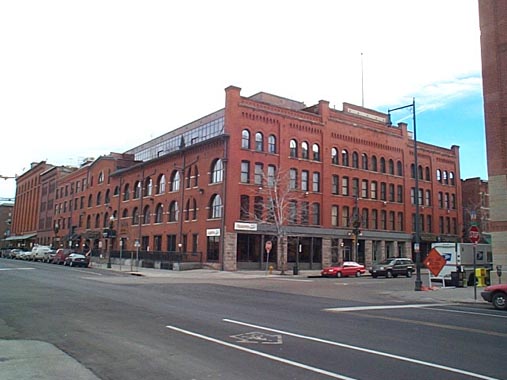
Photo: N/A
More About This Topic
The Hendrie and Bolthoff building has been recognized as one of the best examples of 19th century warehouses in Denver. The right hand face of the building was changed in 1892 by the Baerresen brothers. The architect-brothers immigrated from Denmark to Denver and established their firm in 1887. A number of their buildings have been listed in the National Register of Historic buildings. The interior of this building has recently been remodeled for office and retail uses.
Struby-Estabrooke Warehouse
Located at the corner of 17th and Wynkoop Streets, the Struby-Estabrooke Warehouse was one of the first major warehouses built on Wynkoop Street. This building is across Wynkoop Street from Union Station and across 17th Street from the Denver City Railway Company Building. From that time until well into the 20th century, the Wynkoop Street district became known as "Warehouse Row" because of this and other similar buildings.
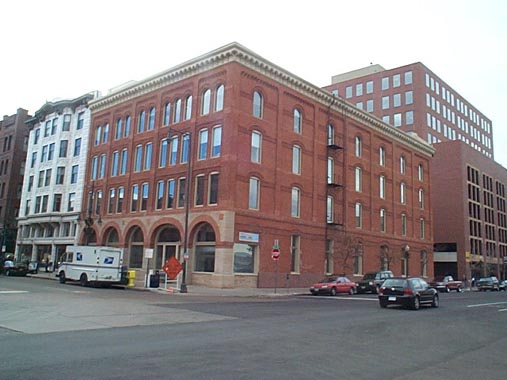
Photo: N/A
More About This Topic
From its beginning, this part of Denver had mixed land uses. Union Station was across Wynkoop Street. The horse-drawn streetcar barn was across 17th Street. The white building to the left was an annex built onto the Oxford Hotel (just out of sight to the left of the white building). Such mixed uses of land are still present today in Lower Downtown Denver. Architect Frank Edbrooke built the Struby-Estabrooke Warehouse in 1885. At the peak of Denver's building boom (from the mid-1880s to 1893), the Romanesque Revival style of architecture came into favor for Lower Downtown buildings. This building was one of the first to be built in this style. The wide arches of the first floor were Romanesque. The rough-cut stone around the arches and the solid four-story brick give the building a massive feel.
Oxford Hotel
The 400-room Oxford Hotel was finished in 1891. The hotel became popular from the beginning. It had an ideal location just a block from Union Station. The hotel was also known for excellent service and food and for moderate rates. Business grew steadily. By 1902, the owners built a 50-room two-story addition in the same style as the original (left side of the photo). The white building to the right is the Oxford Hotel Annex. This was yet another addition to the original Oxford Hotel.
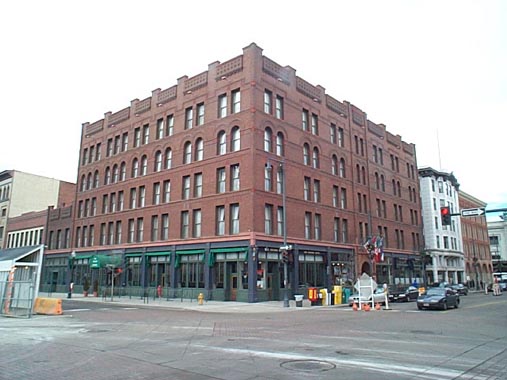
Photo: N/A
More About This Topic
The Oxford Hotel is significant for its role in Denver's commerce and for its association with several notable Denver architects. Frank Edbrooke built the original five-story hotel building. Edbrooke was the architect of many buildings erected in downtown Denver in the 1880s and 1890s. Many of these, including the Brown Palace Hotel and the Oxford Hotel, are listed in the National Register of Historic Places.
Union Warehouse / Barth Hotel
Construction began on the Union Warehouse in 1882 and continued into 1883. The building is located on 17th Street at Blake Street, in the heart of the Lower Downtown area. Its building was part of a spurt of growth begun with the opening of Union Station, just a couple of blocks away down 17th Street. Sometime in the late 1880s, the building was converted from its first use as a warehouse to the Union Hotel.
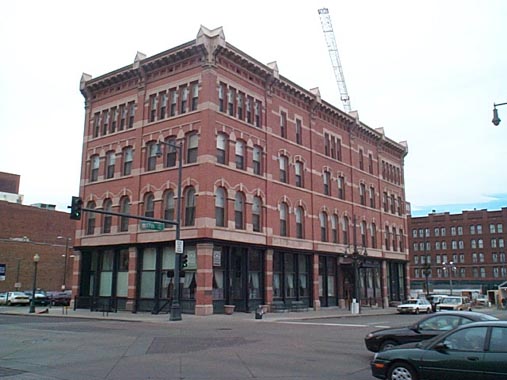
Photo: N/A
More About This Topic
By the end of the 19th century, the hotel was known as the New Union Hotel. After 1905, it was known as the Elk Hotel and after 1921 the New Elk Hotel. Around 1930, Allen Barth bought and remodeled the property and renamed it the Barth Hotel. It has been known by that name since. The hotel, however, began a slow decline as did the area around it. When the Lower Downtown area began to revive, so did this building. In 1892, Illustrated Denver noted the Union Hotel was an "elegant brick affair. . . with 100 rooms, all well lighted, perfectly ventilated and furnished in the most elegant and most attractive manner." At that time, the hotel did not have its current floor plan. It had no ground floor lobby, and the hotel dining room was on the second floor. The building was built by F.C. Eberley, a prominent Denver architect, who also built many of Denver's mansions. This building is still a hotel.
Brown Palace Hotel
Although there have been many changes in the interior decor, the Brown Palace Hotel appears now much as it did when built. The design of the building was a triangle because of the block it occupied between Tremont, Broadway, and 17th Street. It was the second fire-proof building in the United States. The structural frame was steel and iron on a foundation of granite rock. The exterior facing was red granite and flagstone.
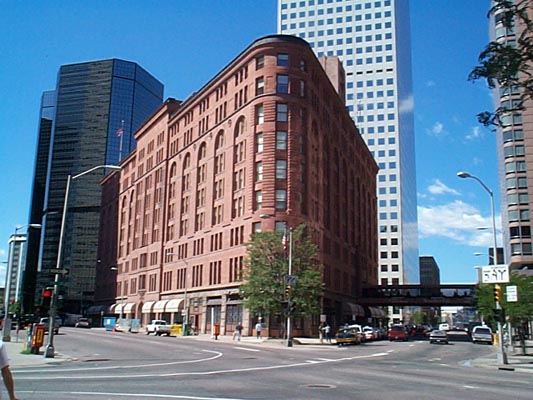
Photo: N/A
More About This Topic
The Brown Palace was one of Denver's first skyscrapers, rising 10 stories above the street. It had 400 rooms and a lobby that was 8 stories high. The walls of the public places in the hotel were made of Mexican onyx. The hotel maintained a reading room for its guests, an unusual service for the time. Water for the hotel came from 700 foot wells drilled below the hotel. These are still in use even though the hotel is now connected to Denver's water system. Architect Edward Edbrooke oversaw construction of the Brown Palace. The building was and is significant in many ways. It was an impressive building in terms of architecture and engineering. It was also important as a social and cultural landmark in Denver. The silver strikes in the nearby Rockies drew European and eastern bankers to the region. These people demanded better places to stay and more things to do (such as opera houses and theaters) than most western towns had to offer. The Brown Palace is still an up-scale hotel.
The Old Navarre
When originally built, the Navarre housed the Brinker Collegiate Instiute. This private school was one of the first colleges west of the Mississippi River to have both male and female students. Among its offerings were music, art, business, and military courses. The first two floors housed classrooms, parlors, the kitchen, the president's office and a chapel. The third and fourth floors were dormitories for the female and male students. The school became known for its educational excellence, but closed upon the death of its founder.
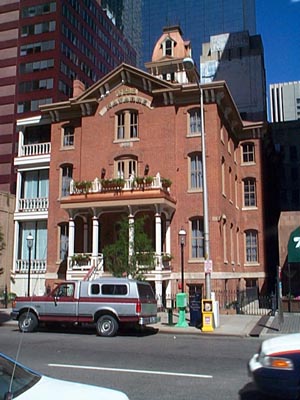
Photo: N/A
More About This Topic
The Old Navarre building had a colorful history and continues as a reference point in upper downtown Denver. It is close to the Trinity Methodist Church and is across Tremont Place from the Brown Palace. In fact, the two buildings were connected by an underground tunnel (coal was delivered to the two buildings that way). Since its use as a private college in the 1880s, the building has housed an number of different businesses. It recently was the home for the Museum of Western Art. Now offices occupy the building.
Trinity Methodist Church
The Trinity Methodist Church was built between 1887 and 1888. Those who nominated the building for National Registry as an Historic Place noted that the building is like a cathedral, "rising in beauty and majesty." In addition, they claimed that the church spire (measuring 181 feet, 7.5 inches) is the highest church steeple in the world from ground to top. The architecture is Gothic. The volcanic granite (known as rhyolite) from which it was built gives the building a massive, grounded feel.
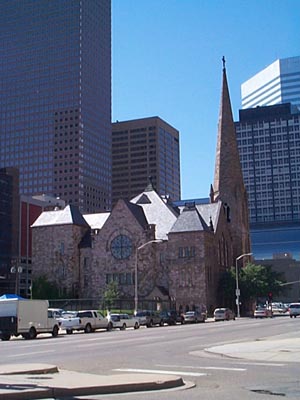
Photo: N/A
More About This Topic
The granite stone (rhyolite) from which the building was made was quarried in Castle Rock, Colorado. The stone is a light beige with hints of red and blue and the glitter of mica. The stone was quarried in various sizes and laid in distinct horizontal bands. By 1964, the granite stone had weathered to a dark gray. That year, the stone was cleaned to reveal the wonderful colors of the native stone.
Equitable Building
The Equitable building was completed in 1892 during the building boom that occurred in the 1880s and early 1890s in Denver. At the time, Denver business leaders were self-conscious of the city's frontier image and they wanted to see Denver become a city of national importance. Then the Equitable Assurance Company decided to built its western headquarters in Denver. When it was completed, the Equitable Building was by far the tallest in Denver. Its presence on 17th Street attracted other similar businesses and buildings there.
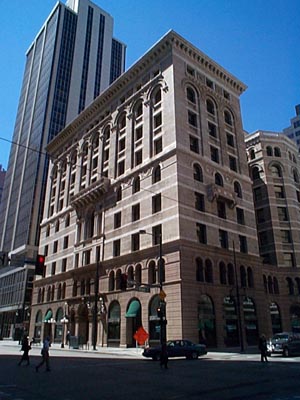
Photo: N/A
More About This Topic
The Equitable building had its own electrical and water systems. To this day, the artesian well in the basement runs the building's eight elevators. When built, each room had radiators for steam heat. Most of the offices had water closets (bathrooms) and hot and cold running water. Many of the offices also had gas fireplaces. Because of these amenities and the building's elegance, it attracted many wealthy tenants. These included railroad and mining interests as well as many of Denver's most important lawyers.
Boston Building
The Boston building was one of the first commercial office buildings constructed in Denver's financial district. When it was built in 1890, the Boston building had the latest and most up-to-date design in office construction. Denver historian Jerome Smiley noted that this building was the first "strictly modern office building" in Denver. As such, the building attracted leading business concerns as its tenants. Among its first occupants were the Postal Telegraph and Cable Company and the Colorado Midland Railroad Company, among many others.
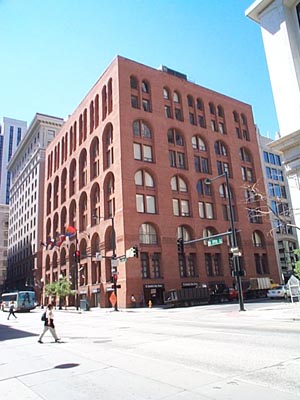
Photo: N/A
More About This Topic
The Boston building is one of the few remaining examples of 19th century commercial architecture in the downtown area built before the silver crash of 1892-1893. The Boston building adapted to present-day business office needs even as it is surrounded by new types and styles of construction. In the words of those who nominated the building for National Registry of Historic Places, "it is a warm contrast to the steel and concrete of its neighbors and stands proud and tall as a beautiful monument to a bygone era: Victorian Denver."
Ideal Building
The Ideal building was built in 1907. It is located on the northeast corner of 17th and Champa Streets. It is an eight-story structure with a ninth story "penthouse". The building was built of reinforced concrete. It is said to be the first multi-story building built of concrete west of the Mississippi River. On the exterior, the first two floors are faced with large blocks of marble (from Cotopaxi, Colorado). The other six floors were faced with brick. Since the 1920s, though, these walls have been covered with stucco.
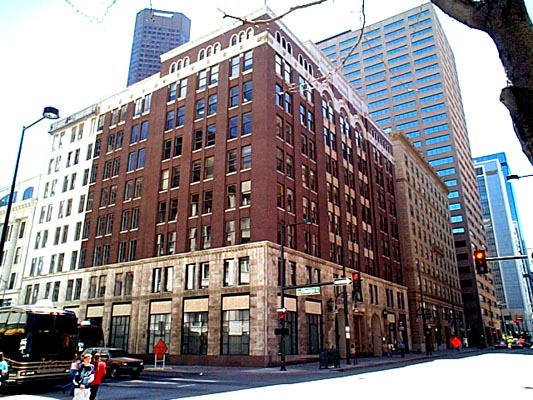
Photo: N/A
More About This Topic
The Ideal building is significant because it was the first multi-story building constructed of reinforced concrete west of the Mississippi River. In addition, it was and continues to be an important center of financial activity in the West. One of the reasons the building became a National Registry of Historic Places site was that it was "one of the cornerstones of 17th Street, Denver's Wall Street [an important financial district]."
First National Bank Building
The First National Bank building was completed in 1911. Its builders took advantage of a recent change in Denver's laws governing the height of buildings. The First National Bank had been organized in Denver in 1865. It occupied this building from 1911 until 1958. The American National Bank occupied the building from 1962 to 1981. The Holtze Brothers Development Corporation completed a $21 million rehabilitation of the building in 1995. The building now houses a 250-room hotel as well as office and retail space.
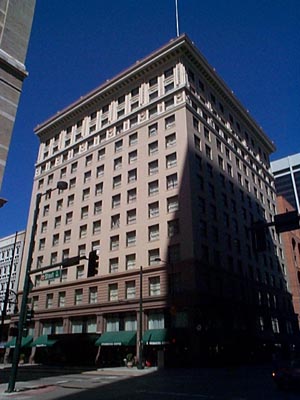
Photo: N/A
More About This Topic
The 13-story First National Bank building was the first building of more than 10 stories in Denver. At the time, the building set new standards for new construction. The Denver Times called the building Denver's first skyscraper. The First National Bank was the first bank to locate its offices on 17th Street. It attracted many other such institutions to locate there.
US National Bank Building
The U.S. National Bank building is located at 17th and Stout Streets. It is a 10-story commercial building made of steel and concrete structural frame and a limestone exterior. At the street level is an ornamental bronze storefront. The building was completed in 1921. The building was designed in the so-called Chicago Commercial style. This design usually consisted of five to sixteen stories, flat roofs, and very regular patterns of rectangular windows. These buildings usually had more window area than other facing building materials.
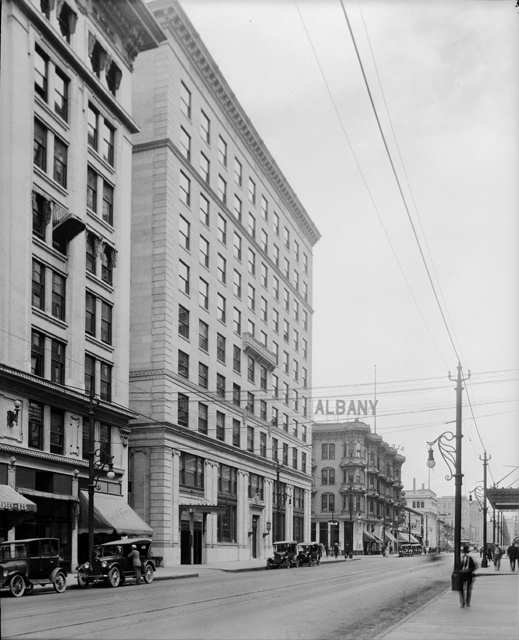
Photo: N/A
More About This Topic
The architectural firm, Fisher and Fisher, designed the U.S. National Bank Building. According to historians Tom Noel and Barbara Norgren, "By 1920 the firm had established itself as one of the largest and most influential architectural firms in the Rocky Mountain region." The Fishers also designed many other buildings in Denver, including the Neusteter Department Store. The Fishers employed elements of many styles. But for the U.S. National Bank they emphasized a classical style, an appropriate image for banking.
- Colorado Indians Tour One
- Georgetown's Historic Houses
- Georgetown's Historic Stores
- An 1860's Farm
- An 1890's Farm
- Denver's Historic Larimer Square
- Denver's Historic Lower Downtown
- Denver's Historic 17th Street
- The Lebanon Silver Mine
- Denver's Historic Civic Center
- Denver's Historic Uptown District
- Virtual Field Trips Home

